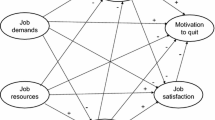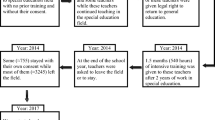Abstract
Studies related to reasons why teachers stay are far less frequent than those reporting reasons to leave. This study assessed the factors that satisfied PE teachers and the motivators to stay in PE teaching. Physical educator stayers (N = 139) responded to a ‘PE Teachers’ Career Intentions Questionnaire’, ‘Basic Satisfaction Needs at Work Scale’ and an open-ended question to ascertain retention motivators. Basic needs satisfaction for competence, autonomy and relatedness support, along with satisfaction for ‘professional interaction’, ‘participation in decision-making’, ‘organisation of teaching’, and ‘respect’ predicted retention. PE teachers gain work-related motivation from their expertise, the opportunity to implement ideas collaboratively, but also the sense of efficacy to control their pedagogy and student outcomes of focus. Supportive policy and actions; not just the absence of career-thwarting stimuli, appear vital for teacher self-efficacy, leading to career fulfillment. Quality mentoring programs may serve to enhance PE teacher satisfaction and are worthy of further investigation.
Similar content being viewed by others
References
Al-Mohannadi, A., & Capel, S. (2007). Stress in physical education teachers in Qatar. Social Psychology of Education, 10, 55–75. https://doi.org/10.1007/s11218-006-9004-9.
Armour, K. M., & Jones, R. L. (1998). Physical education teacher’s lives and careers: PE, sport, and educational status. London: Falmer Press.
Baard, P. P., Deci, E. L., & Ryan, R. M. (2004). Intrinsic need satisfaction: A motivational basis of performance and well-being in two work settings. Journal of Applied Psychology, 34, 2045–2068.
Ball, S. J. (2013). The education debate (2nd ed.). Bristol: The Policy Press.
Bizet, I., Laurencelle, L., Lemoyne, J., Larouche, R., & Trudeau, F. (2010). Career changes among physical educators: Searching for new goals or escaping a heavy task load? Research Quarterly for Exercise and Sport, 81, 224–232.
Carson, R. L., & Chase, M. A. (2009). An examination of physical education teacher motivation from a self-determination theoretical framework. Physical Education and Sport Pedagogy, 14, 335–353.
Dagenais-Desmarais, V., Forest, J., Girouard, S., & Crevier-Braud, L. (2010). The importance of need-supportive relationships for motivation and psychological health at work. In N. Weinstein (Ed.), Human motivation and interpersonal relationships—Theory, research, and applications (pp. 263–297). Dordrecht: Springer, Netherlands.
Day, C. (2002). School reform and transitions in teacher professionalism and identity. International Journal of Educational Research, 37, 677–692. https://doi.org/10.1016/S0883-0355(03)00065-X.
Day, C., Elliot, B., & Kington, A. (2005). Reform, standards and teacher identity: Challenges of sustaining commitment. Teaching and Teacher Education, 21, 563–577. https://doi.org/10.1016/j.tate.2005.03.001.
Deci, E. L., Connell, J. P., & Ryan, R. M. (1989). Self-determination in a work organization. The Journal of Applied Psychology, 74, 580–590. https://doi.org/10.1037/0021-9010.74.4.580.
Deci, E. L., La Guardia, J. G., Moller, A. C., Scheiner, M. J., & Ryan, R. M. (2006). On the benefits of giving as well as receiving autonomy support: Mutuality in close friendships. Personality and Social Psychology Bulletin, 32, 313–327.
Deci, E. L., Ryan, R. M., Gagné, M., Leone, D. R., Usunov, J., & Kornazheva, B. P. (2001). Need satisfaction, motivation, and well-being in the work organizations of a former Eastern bloc Country: A cross-cultural study of self-determination. Personality and Social Psychology Bulletin, 27, 930–942. https://doi.org/10.1177/0146167201278002.
Dinham, S. (1994). Societal pressures and teaching. In Paper presented at the Annual Conference of the Australian Association for Reseach in Education, Newcastle, New South Wales, Australia.
Dinham, S., & Scott, C. (2000). Teachers’ work and the growing influence of societal expectations and pressures. In Paper presented at the Annual Meeting of the American Educational Research Association, New Orleans, LA.
Ensign, J., & Woods, A. M. (2016). Navigating the realities of the induction years: Exploring approaches for supporting beginning physical education teachers. Quest. https://doi.org/10.1080/00336297.2016.1152983.
Evans, J., & Williams, T. (1989). Moving up and getting out: The classed, gendered career opportunities of physical education teachers. In T. Templin & P. Schempp (Eds.), Socialization in physical education: Learning to teach (pp. 235–250). Indianapolis: Benchmark Press.
Gagné, M., & Deci, E. L. (2005). Self-determination theory and work motivation. Journal of Organizational Behavior, 26, 331–362.
Gairns, F., Whipp, P. R., & Jackson, B. (2015). Relational perceptions in high school physical education: Teacher- and peer-related predictors of female students’ motivation, behavioral engagement, and social anxiety. Frontiers in Psychology, 6, 850. https://doi.org/10.3389/fpsyg.2015.00850.
Gillet, N., Fouquereau, E., Forest, J., Brunault, P., & Colombat, P. (2012). The impact of organizational factors on psychological needs and their relations with well-being. Journal of Business and Psychology, 27, 437–450.
Greguras, G. J., & Diefendorff, J. M. (2009). Different fits satisfy different needs: Linking person-environment fit to employee commitment and performance using self-determination theory. Journal of Applied Psychology, 94, 465–4477. https://doi.org/10.1037/a0014068.
Hargreaves, A., & Shirley, D. (2012). The far side of educational reform. Canadian Teachers’ Federation. ISBN 978-0-88989-385-6.
Henninger, M. L. (2007). Lifers and troupers: Urban physical education teachers who stay. Journal of Teaching in Physical Education, 26, 125–144.
Kennedy, K. J. (2001). The teacher quality debate: Focusing on the professional and personal dimension. In K. J. Kennedy (Ed.), Beyond the rhetoric: Building a teaching profession to support quality teaching (pp. 2–11). Canberra: Australian College of Education Yearbook.
Kougioumtzis, K., Patriksson, G., & Stråhlman, O. (2011). Physical education teachers’ professionalization: A review of occupational power and professional control. European Physical Education Review, 17, 111–129. https://doi.org/10.1177/1356336X11402266.
LeCompte, M. D., & Dworkin, A. G. (1991). Giving up on school: Student dropouts and teacher burnouts. Newbury Park, CA: Corwin Press.
Louis, K. S., & Smith, M. B. (1990). Teacher working conditions. In P. Reyes (Ed.), Teachers and their workplace: Commitment, performance and productivity (pp. 23–47). Newberry Park, CA: Sage.
Lynn, S. K., & Woods, A. M. (2010). Following the yellow brick road: A teacher’s journey along the proverbial careerp path. Journal of Teaching in Physical Education, 29, 54–71.
Macdonald, D. (1999a). The “professional” work of experienced physical education teachers. Research Quarterly for Exercise and Sport, 70, 41–54.
Macdonald, D. (1999b). Teacher attrition: A review of literature. Teaching and Teacher Education, 15, 835–848.
Mäkelä, K., & Hirvensalo, M. (2015). Work ability of Finnish physical education teachers. The Physical Educator, 72, 384–398.
Mäkelä, K., Hirvensalo, M., Laakso, L., & Whipp, P. R. (2014a). Physical education teachers in motion: An account of attrition and area transfer. Physical Education & Sport Pedagogy, 19, 418–435. https://doi.org/10.1080/17408989.2013.780590.
Mäkelä, K., Hirvensalo, M., & Whipp, P. R. (2014b). Should I stay or should I go? Physical education teachers’ career intentions. Research Quarterly for Exercise and Sport, 85, 234–244.
Mäkelä, K., Hirvensalo, M., & Whipp, P. R. (2015). Determinants of PE teachers career intentions. Journal of Teaching in Physical Education, 34, 680–699.
Mäkelä, K., & Whipp, P. R. (2015). Career intentions of Australian physical education teachers. Journal of Teaching in Physical Education, 21, 504–520.
Manross, D., & Templeton, C. L. (1997). Expertise in teaching physical education. Journal of Physical Education, Recreation & Dance, 68, 29–35.
Moreau, E., & Mageau, G. A. (2012). The importance of perceived autonomy support for the psychological health and work satisfaction of health professionals: Not only supervisors count, colleagues too! Motivation and Emotion, 36, 268–286.
Moreira, H. (1995). Physical education teachers and job commitment: A preliminary analysis. European Physical Education Review, 1, 122–136.
Moreira, H., Fox, K., & Sparkes, A. C. (2002). Job motivation profiles of physical educators: Theoretical background and instrument development. British Educational Research Journal, 28, 845–861. https://doi.org/10.1080/014119202200001909.
O’Sullivan, M. (2006). Professional lives of Irish physical education teachers: Stories of resilience, respect and resignation. Physical Education and Sport Pedagogy, 11, 265–284.
Parker, M., Patton, K., & Tannehill, D. (2012). Mapping the landscape of communities of practice as professional development in Irish physical education. Irish Educational Studies, 31, 311–327.
Perrachione, B. A., Rosser, V. J., & Petersen, G. J. (2008). Why do they stay? Elementary teachers’ perceptions of job satisfaction and retention. Professional Educator, 32, 25–41.
Plucker, J. A., & Slavkin, M. L. (2000). Unify curriculum around the needs of students, teachers and community alike. The Education Digest, 66, 55–60.
Richards, K. A. R. (2015). Role socialization theory: The sociopolitical realities of teaching physical education. European Physical Education Review, 21, 379–393.
Richards, K. A. R., Gaudreault, K. L., Woods, A. M. (2016). Understanding physical educators’ preceptions of mattering: Validation of the perceived mattering questionnaire—physical education. European Physical Education Review. Advance online publication. https://doi.org/10.1177/1356336x16637320.
Ryan, R. M., & Deci, E. L. (2000). Self-determination theory and the facilitation of intrinsic motivation, social development, and well-being. The American Psychologist, 55, 68–78. https://doi.org/10.1037/0003-066X.55.1.68.
Sandmark, H. (2000). Musculoskeletal dysfunction in physical education teachers. Occupational and Environmental Medicine, 57, 673–677.
Sandmark, H., Wiktorin, C., Hogstedt, C., Klenell-Hatschek, E.-K., & Vingård, E. (1999). Physical work load in physical education teachers. Applied Ergonomics, 30, 435–442. https://doi.org/10.1016/S0003-6870(98)00048-9.
Smith, D., & Leng, G. W. (2003). Prevalance and sources of burnout in Singapore secondary school physical education teachers. Journal of Teaching in Physical Education, 22, 203–218.
Smylie, M. A., Lazarus, V., & Brownlee-Conyers, J. (1996). Instructional outcomes of school-based participative decision making. Educational Evaluation and Policy Analysis, 18, 181–198.
Tabachnick, B., & Fidel, L. S. (2013). Using multivariate statistics (6th ed.). Boston: Pearson Education.
Tschannen-Moran, M. (2009). Fostering teacher professionalism in schools: The role of leadership orientation and trust. Educational Administration Quarterly, 45, 217–247. https://doi.org/10.1177/0013161X08330501.
Watt, H. M. G., Richardson, P. W., Klusmann, U., Kunter, M., Beyer, B., Trautwein, U., et al. (2012). Motivations for choosing teaching as a career: An international comparison using the FIT-Choice scale. Teaching and Teacher Education, 28, 791–805. https://doi.org/10.1016/j.tate.2012.03.003.
Webb, R., Vulliamy, G., Hämäläinen, S., Sarja, A., Kimonen, E., & Nevalainen, R. (2004). Pressures, rewards and teacher retention: A comparative study of primary teaching in England and Finland. Scandinavian Journal of Educational Research, 48, 169–188. https://doi.org/10.1080/0031383042000198530.
Whipp, P. R., & Pengelley, R. (2016). A qualitative evaluation of a mentoring program for health and physical education teachers. Advances in Physical Education, 6, 103–115.
Whipp, P. R., Tan, G., & Yeo, P. T. (2007). Experienced physical education teachers reaching their “use-by date”: Powerless and disrespected. Research Quarterly for Exercise and Sport, 78, 487–499.
Woods, A. M., & Lynn, S. K. (2014). One physical educator’s career cycle: Strong start, great run, approaching finish. Research Quarterly for Exercise and Sport, 85, 68–80.
Author information
Authors and Affiliations
Corresponding author
Ethics declarations
Conflict of interest
The authors declare that they have no conflict of interest.
Rights and permissions
About this article
Cite this article
Whipp, P.R., Salin, K. Physical education teachers in Australia: Why do they stay?. Soc Psychol Educ 21, 897–914 (2018). https://doi.org/10.1007/s11218-018-9443-0
Received:
Accepted:
Published:
Issue Date:
DOI: https://doi.org/10.1007/s11218-018-9443-0




